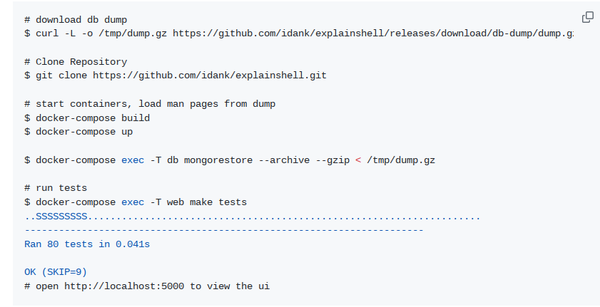Explainshell – A New Use for Man Pages
A More Modern Man Page

Photo by Brett Jordan on Unsplash
Explainshell aims to make documentation more accessible.
Man pages are the most common form of documentation for Linux. However, they first appeared in 1971, designed for a small audience of experts. As a result, while they generally provide an exhaustively thorough summary of their topics, from a modern perspective, they can have several limitations. Their thoroughness can be intimidating for new users, and some contain numerous options, many of which are obscure because they are not frequently combined. Nor do they always cover which multiple commands are combined through pipes or joined by regular expressions and notations unique to a particular programming language. Consequently, recent years have seen attempts to address these limitations. For instance, tldr provides quick references for the most common use cases of commands. More recently, explainshell has appeared, an online resource that parses commands like high school English classes parse sentences. By doing so, it provides a quick reference to complicated commands, as well as a useful learning tool. If you have ever wondered about the commands for installing software without a package system are about, explainshell can be especially useful. It can also be a handy way to check the validity of commands or Bash scripts.
Explainshell was written by Idan Kamara as part of an ongoing effort to make documentation more accessible. It is based on 29,761 man pages from Ubuntu. As the project's GitHub page explains, explainshell uses Python scripts to convert these pages to HTML, then classifies each paragraph as an option or not. Options are then extracted and stored, and matched to the relevant help text. When a query is made, it is parsed into an Abstract Syntax Tree (AST), and explainshell notes likely relevant commands or shell-related nodes such as pipes. The results are rendered using Flask, a lightweight web application for Python, that makes for quick results. Currently, there is no way to enter any additional man pages, although the GitHub page suggests that might be possible in the future, and it is an obvious way for a small project to grow. The GitHub page also includes instructions about how to install a local version of explainshell using Docker (Figure 1), as well as how to parse and save a gzipped man page in raw format (Figure 2).

[...]
Buy Linux Magazine
Subscribe to our Linux Newsletters
Find Linux and Open Source Jobs
Subscribe to our ADMIN Newsletters
Support Our Work
Linux Magazine content is made possible with support from readers like you. Please consider contributing when you’ve found an article to be beneficial.

News
-
AUR Repository Still Under DDoS Attack
Arch User Repository continues to be under a DDoS attack that has been going on for two weeks.
-
RingReaper Malware Poses Danger to Linux Systems
A new kind of malware exploits modern Linux kernels for I/O operations.
-
Happy Birthday, Linux
On August 25, Linux officially turns 34.
-
VirtualBox 7.2 Has Arrived
With early support for Linux kernel 6.17 and other new additions, VirtualBox 7.2 is a must-update for users.
-
Linux Mint 22.2 Beta Available for Testing
Some interesting new additions and improvements are coming to Linux Mint. Check out the Linux Mint 22.2 Beta to give it a test run.
-
Debian 13.0 Officially Released
After two years of development, the latest iteration of Debian is now available with plenty of under-the-hood improvements.
-
Upcoming Changes for MXLinux
MXLinux 25 has plenty in store to please all types of users.
-
A New Linux AI Assistant in Town
Newelle, a Linux AI assistant, works with different LLMs and includes document parsing and profiles.
-
Linux Kernel 6.16 Released with Minor Fixes
The latest Linux kernel doesn't really include any big-ticket features, just a lot of lines of code.
-
EU Sovereign Tech Fund Gains Traction
OpenForum Europe recently released a report regarding a sovereign tech fund with backing from several significant entities.

